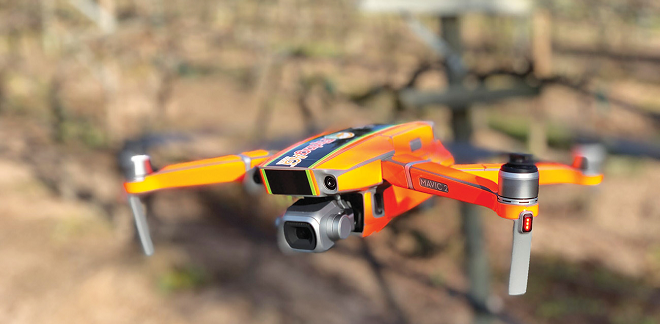

Jul 10, 2023Drone deployment: Tech helps growers in orchards, vineyards
This is the first in a three-part series, focusing on the rising use of drones in specialty ag operations and the growing number of tasks they can do. Future installments will look at costs and the pros and cons of owning vs.
leasing, and what the future holds for drone technology.
Unmanned aerial systems (UAS) — drones — are becoming more popular in grower operations. The devices are gaining a foothold in fields, orchards and vineyards.
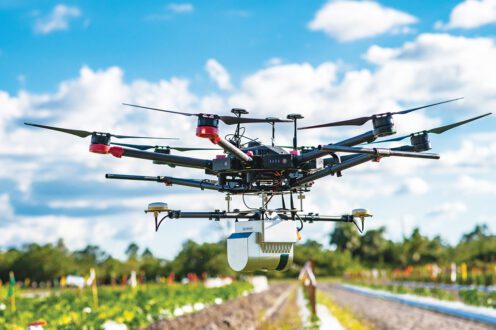

Drones are taking on more labor-intensive tasks as technology improves, allowing farmers to carry out traditional tasks like spraying for pests. They’ve also opened the door to new opportunities, efficiently gathering valuable data for comprehensive crop analysis and decision-making.
“Drones in agriculture overall have become more and more prevalent,” said Ittai Marom, general manager of Israel-based Tevel Aerobotics Technologies. “They are used for different operations, whether spraying or taking photos or fruit counting or disease detection, you name it. Drones have gained many capabilities. They can stay longer in the air and can carry more and more payloads of different kinds.”
Hein Ranch Co., a Visalia, California, grower and farm properties manager of almonds, walnuts, pistachios and table, wine and cannery grapes, as well as citrus and avocados, uses drones in spray platforms, and to deploy beneficial insects and release pheromones to disrupt mating of pests.
“We’re seeing a lot of benefits,” said Martin Hein, co-owner and one of a group of farmers who are partners in FlyingAg, which also has Midwest row crop clients who use them to apply herbicide.
FlyingAg is a growers collective that advises farmers in UAS product selection and use of aerial imaging.
Drones allow growers to access marshy and other difficult areas, and knock out noxious weeds. Because receiving images and reports from satellite imaging companies can sometimes entail waits of up to a week, the immediacy of drone images improves grower efficiencies, Hein said.
Farmers can also use drones to make more informed decisions in pest management, crop monitoring and resource allocation, said Chad Colby, agricultural technologist consultant to FlyingAg.com and owner of ColbyAgTech.com.
Cutting costs
“This technology not only improves productivity and efficiency, but also contributes to sustainable agricultural practices by reducing chemical inputs and optimizing resource utilization,” Colby said.
“Drones are transforming the way farmers approach crop management, enabling them to achieve higher yields, reduce costs and enhance overall farm performance.”
Tevel’s fruit-picking flying autonomous robots are helping growers deal with labor shortages. Artificial intelligence and computer vision algorithms power “hands” on the flying robots which pick tree fruit.
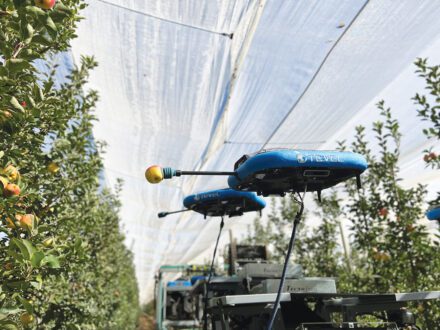

At HMC Farms in Kingsburg, California, Tevel’s robots harvest stone fruit, including peaches, nectarines and plums. While many technologies are focused on the larger apple industry, Drew Ketelsen, HMC’s vice president, said it’s good that other tree fruit industries can benefit.
“These flying robots are a simple and novel solution as far as freedom of mobility,” Ketelsen said. “They go up and down, left and right, and turn side to side. It’s all the motion of the fans, moving up and down and doing all those motions autonomously without having to be attached to a big piece of equipment.
“You’ve got a place for it to drop the fruit and load the fruit into a bin, and it flies around,” Ketelsen said. “This little 2-foot-by-2-foot machine can go wherever it needs to go to pick the fruit. It seems really efficient and a smart way to move along the harvest.”
While Tevel drones at HMC are primarily used for harvesting, they can also provide per-piece-level data. Knowing size breakdowns is important for supplying customers harvest information and helps manage the packing by providing information on what’s coming from the fields, Ketelsen said.
Crop reveal
Other drones fly over HMC’s vineyards for field analysis. The company uses plastic to protect table grapes from rain and wind, and drone images show areas of weakness and where the plastic requires repair, avoiding the time-consuming need to walk vineyard rows.
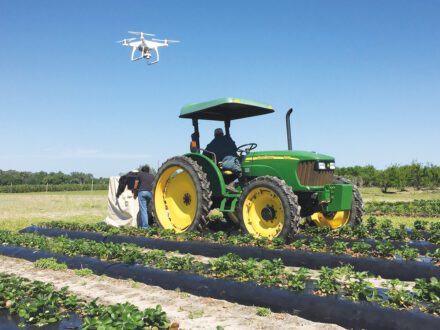

Agricultural technology company Hylio manufactures UAS for precision crop treatment applications. The Houston-based Hylio helps growers apply crop treatments directly to problem areas, allowing growers to increase yields by addressing pests and deficiencies with more accuracy and efficacy, said Arthur Erickson, CEO and co-founder.
“The traditional methods for spraying are great, but if your ground is muddy, if you have an area, let’s say, like a 5- or 10-acre patch of field that has a lot of fence lines or trees going through it, it’s going to be extremely difficult, if not downright impossible, for that tractor to get out and treat your crops,” Erickson said. “It’s a binary thing. It’s either a farmer wouldn’t have even treated these 20 or 30 acres. Now he can treat those 20 or 30 acres and get good yields out of them that he otherwise couldn’t even reach with his traditional equipment.
“Drones are unlocking applications that otherwise couldn’t even have been done with the current physical tools,” he said.
Drones optimize crop scouting, which helps growers understand crop progress on a farm-wide scale, said Adityah Singh, assistant professor of agricultural and biological engineering at the University of Florida (UF). While specialized sensors may be required for identifying specific issues, basic RGB or multispectral sensors can detect signs of wilting or changes in coloration and provide information to assess and monitor overall crop development, Singh said.
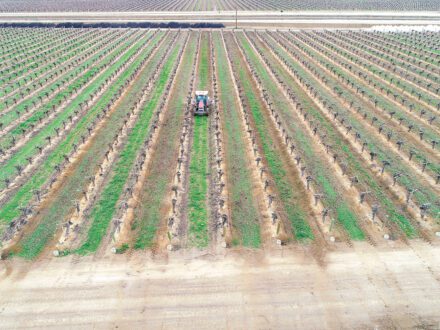

vineyards like this table grape vineyard in Kern county, California.
Photo courtesy of ColbyAgTech.
“Drones can be outfitted with thermal imagers to map crop canopy temperature, providing valuable insights into water stress,” Singh said. “Well-hydrated crops typically appear cooler due to evapotranspiration, making it possible to identify areas of concern. However, converting canopy temperatures into precise estimates of evapotranspiration or water demand requires further steps and is an active area of research at UF.”
The challenge of drone imagery is how to properly evaluate the data. Analytic tools are precise and should be calibrated so a grower can fly a drone from one orchard to another or even a neighbor’s property, and not receive inconsistent data, said Ali Pourreza, assistant professor and agricultural engineering Extension specialist and advisor in the biological and agricultural engineering department at the University of California, Davis.
“Data collection is one part of the challenge, but data analytics is also an important part because if we get good data, but we don’t have a good algorithm, that data is useless and maybe even misleading,” Pourreza said.
— Doug Ohlemeier, assistant editor
Top photo: Drones improve crop scouting, helping growers understand crop progress on a farm-wide scale. Photo courtesy of ColbyAgTech.














